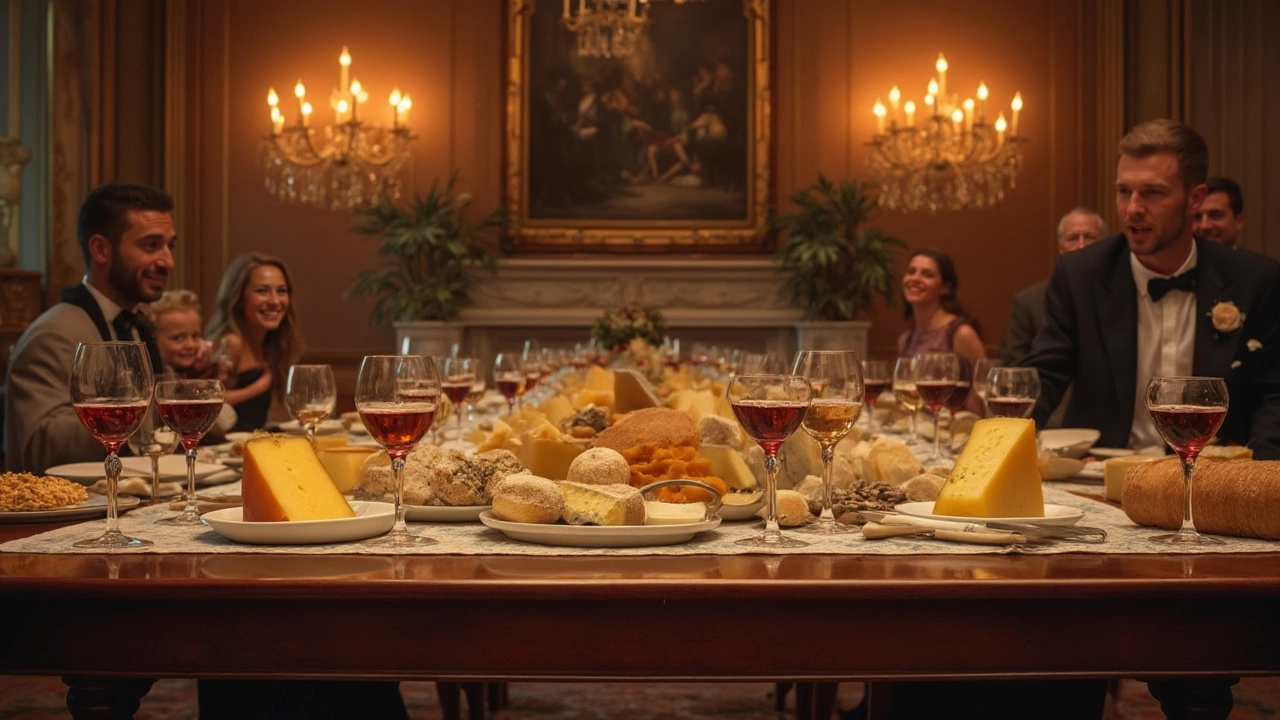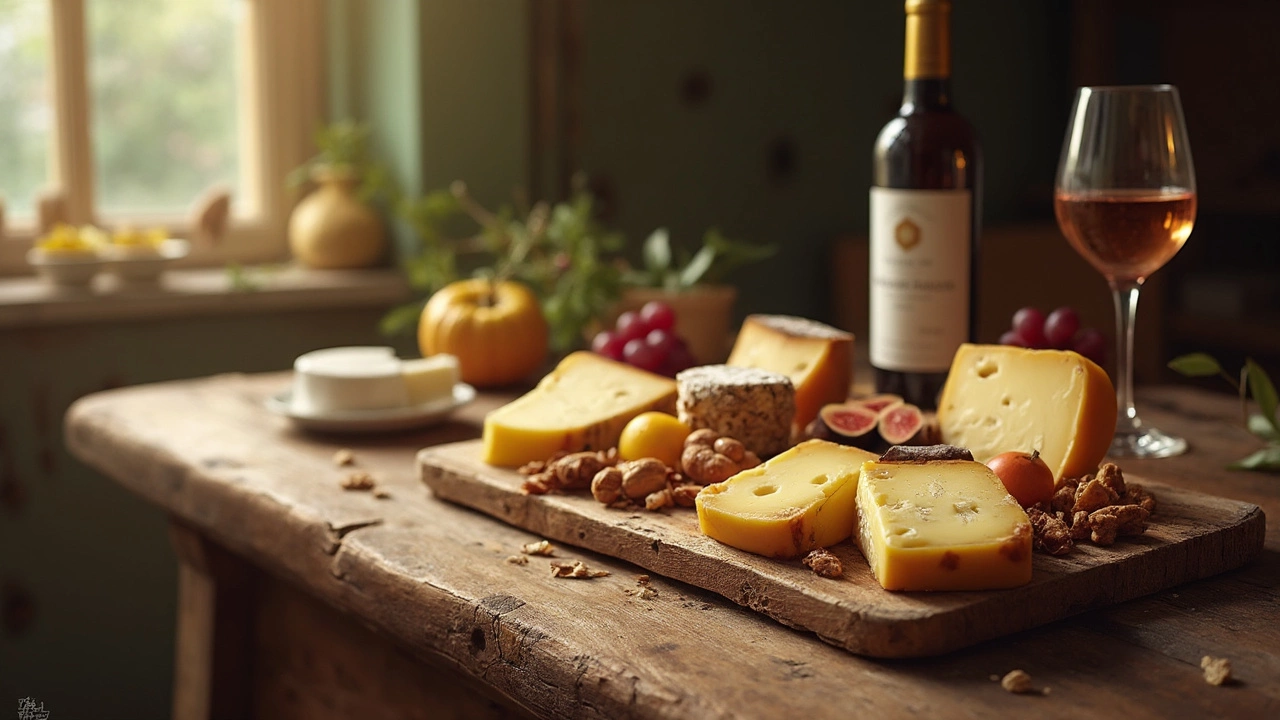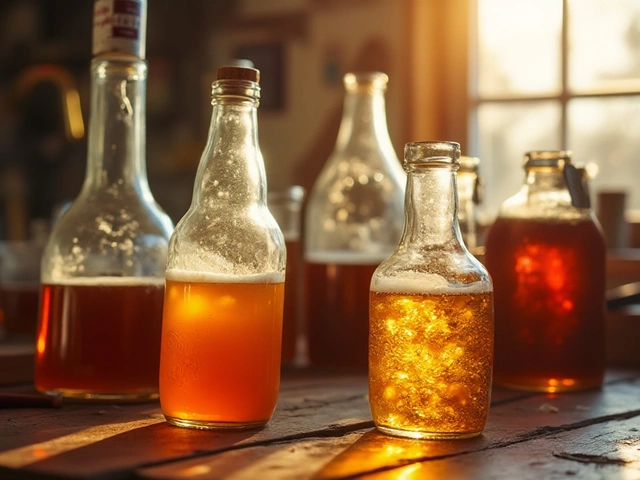Ever wondered what magic happens when you pair a cheese platter with the perfect wine? Well, it's not just a snack; it's an experience. Knowing the right mix can take your taste buds on a delightful journey. A cheese platter with wine is actually called a 'wine and cheese pairing,' a classic for gatherings. It's all about finding the right harmony between different cheese textures and wine qualities.
Let's face it, not all cheeses work with all wines. The key is to understand the characteristics. Some wine might enhance a cheese's flavor, while others might overpower it. So, what makes a killer cheese platter? It's a simple mix of textures and tastes—think creamy brie, tangy blue cheese, and a sharp cheddar all on one board. But don't forget to balance it with the right wine. It's a bit like matchmaking, only tastier.
- Understanding Cheese and Wine Pairing
- The Art of Selecting Cheeses
- Finding the Perfect Wine Match
- Presentation Tips for Your Platter
- Putting It All Together
Understanding Cheese and Wine Pairing
Diving into the world of cheese platter and wine pairing can seem like a big task, but it's all about knowing a few basics. It's an art with a hint of science, where the right mix can bring out the best in both the cheese and the wine. But how do you know what goes well together?
First off, consider the texture and flavor intensity of the cheese. A strong cheese pairs well with a wine that can stand up to its bold flavors. Think of blue cheese with a sweet port wine—it’s like a match made in heaven. On the flip side, a milder cheese like a creamy brie might be overpowered by a heavy red, so it's better with a light white or a sparkling wine.
Basic Pairing Tips
- Balance the intensity: Match strong cheeses with full-bodied wines and mild cheeses with lighter wines.
- Consider acidity: Acidic wines tend to pair well with creamy cheeses as they cut through the richness.
- Sweet meets salty: Sweet wines pair beautifully with salty cheeses, creating a delicious contrast.
There are no hard and fast rules, but these tips can guide you in crafting your own perfect pairings. Remember, it's about your own taste too, so don’t be afraid to experiment. Next time you're planning a cheese and wine night, use these pointers to impress your friends with your newfound pairing prowess.
The Art of Selecting Cheeses
Creating a standout cheese platter is like crafting a great playlist – variety is key. You want to have a mix of flavors and textures to keep things exciting. Here’s the lowdown on picking your cheeses.
Creamy, Dreamy Cheeses
Start with something creamy, like Brie or Camembert. These soft cheeses are smooth and mild, providing a nice contrast to stronger wines. They're the perfect way to kick off your journey into cheese and wine pairing.
Tangy & Funky Flavors
Add a punch with some blue cheese or goat cheese. Their tangy and earthy flavors can make a strong statement on your platter. These work brilliantly with sweet wines like a Port or a Riesling, cutting through the creaminess with a zesty kick.
Sharp & Aged Selections
No platter is complete without a sharp, aged cheese like Cheddar or Parmesan. These cheeses bring a mature, nutty taste to the party. Pair them with full-bodied reds like Cabernet Sauvignon for a rich and satisfying experience.
Mild & Nutty Options
Don't forget the mild, nutty cheeses, such as Edam or Gruyère. They offer a subtle flavor that pairs well with light to medium-bodied wines like a Chardonnay or Pinot Noir.
Variety Matters
When you're selecting your cheeses, think about balancing textures too. Mix creamy, crumbly, and firm cheeses to keep your platter interesting. It’s about creating a balanced experience where every bite offers something different.
Here's a quick stat to keep in mind: Did you know that the average cheese platter should have at least three to five different types to cater to varied palates? Keep this in mind when curating your platter. It doesn’t just look impressive—it's a guaranteed crowd-pleaser.

Finding the Perfect Wine Match
Pairing wine and cheese is like solving a delicious puzzle. You've got all these different flavors and textures, and when you get it right, it can be magical. But how do you know which wine to pick with your cheese platter? Let's break it down!
White Wines and Cheese
You might think red wine is the go-to for cheese, but white wines, like Chardonnay and Sauvignon Blanc, often do a better job with many cheeses. They bring out the cheese's flavor without overpowering it. If you've got a creamy cheese like brie, try a glass of chilled Chardonnay. It cuts through the richness beautifully.
Red Wines and Cheese
Red wines, such as Cabernet Sauvignon or Merlot, work wonders with harder cheeses. Think about a sharp cheddar or a nutty gouda. These wines have got tannins, which basically are compounds that give the wine its body. They're strong enough to balance the bold flavors of aged cheeses.
Sweet Wines and Blue Cheese
Ever had a sweet sip with something salty? If you're dealing with strong blue cheeses, you should reach for a dessert wine. Something like a Port or Sauternes will do the trick, contrasting the cheese's saltiness with a lovely hint of sweetness.
Rosé and Goats Cheese
Rosé is like the middle ground. It's versatile enough to go with a variety of cheese textures but pairs exceptionally well with fresh goats cheese. The acidity of the wine complements the tangy flavor, offering a refreshing match.
Experiment and Enjoy
The key is to experiment. Everyone's palate is different, so what works for one person might not for another. Have fun creating your own wine pairing combinations. You might stumble upon something unexpectedly delightful!
Here's a simple rule to keep in mind: match the wine's body with the cheese's intensity. Light with light, bold with bold, and sometimes just follow your gut (and taste buds).
Presentation Tips for Your Platter
Having the perfect cheese platter isn’t just about taste—presentation plays a huge role in impressing your guests. It's as much a feast for the eyes as it is for the palate. Let's break it down so you can create a spread that's both picturesque and mouthwatering.
Pick the Right Board
Start with a board that suits the occasion. A wooden or marble board is always a classy choice. The board should be big enough to hold a variety of cheeses, so there's space for everything to breathe and look inviting.
Arrange with Style
Avoid the 'just toss it all on' method. Instead, arrange cheeses by strength, from mild to strong. This way, you won't overwhelm anyone's palate right off the bat. Place the cheeses in a clock-like formation around the board, leaving room for other elements.
Add Variety with Colors and Textures
Include an assortment of colors and textures to make the platter pop. Use fresh fruits, dried nuts, and cured meats to complement your cheeses. Grapes, figs, and walnuts are classic choices. They're not only tasty but they look fantastic too.
Use Labels
Not everyone is a cheese connoisseur, so it's helpful to add little labels. It adds a touch of class and lets guests pick their favorites without guessing. You can write the names on small cards and stick them into the cheeses with toothpicks.
Provide the Right Tools
Make sure you have the right tools for serving. Offer a different knife for each cheese type to prevent flavors from mixing. Make sure they're sharp enough to cut through easily, and remember: a dull knife is worse than no knife.
Take these tips, and your wine and cheese pairing will be unforgettable, both in taste and presentation. Friends will be snapping pics to remember the occasion, trust me.

Putting It All Together
Alright, you've got your cheeses and wines picked out—now what? It's time to create a killer cheese platter and make those wine pairings stand out. Presentation is the key here, and with a few simple steps, you can elevate your gathering from good to unforgettable.
Arranging the Platter
Start by choosing a platter or a board that's big enough to fit everything without looking crowded. Wood or slate boards are popular; they add a rustic charm. Now, you'll want to arrange your cheeses in a way that's inviting. Try grouping them from mild to strong so your guests can appreciate the wide flavor range.
Add some color and texture around your cheeses. Fresh fruit, nuts, and even a few sprigs of herbs can make your platter pop. Plus, they taste great alongside cheese, giving your guests extra nibbling options.
Wine Pairing Tips
Have your wine pairing cards ready. These are little notes next to each cheese that suggest the best wine to sip on. For example:
- Brie: Goes beautifully with a bubbly Champagne.
- Cheddar: Best paired with a robust Merlot.
- Blue Cheese: Try with a sweet Port.
If you have multiple wines, serve them in the order they're likely to be consumed—usually from light to full-bodied. This way, none of the wines will overwhelm the flavors of your cheeses.
Hosting Made Easy
Remember, your cheese should be at room temperature to fully bring out its flavors, so take it out of the fridge about 30 minutes before serving. And don't stress too much about being perfect. The goal is to enjoy the combination of wine and cheese, not to impress with complex pairings.
Here's a quick prep time guide to help you get organized:
| Task | Time |
|---|---|
| Cheese Selection | 10 minutes |
| Board Arrangement | 15 minutes |
| Wine Card Prep | 10 minutes |
| Chill Wines | 30 minutes |
In the end, fun is what it's all about. Chat, laugh, and learn from your own taste experiments. Remember, the experience should be as enjoyable as the wine and cheese itself!


